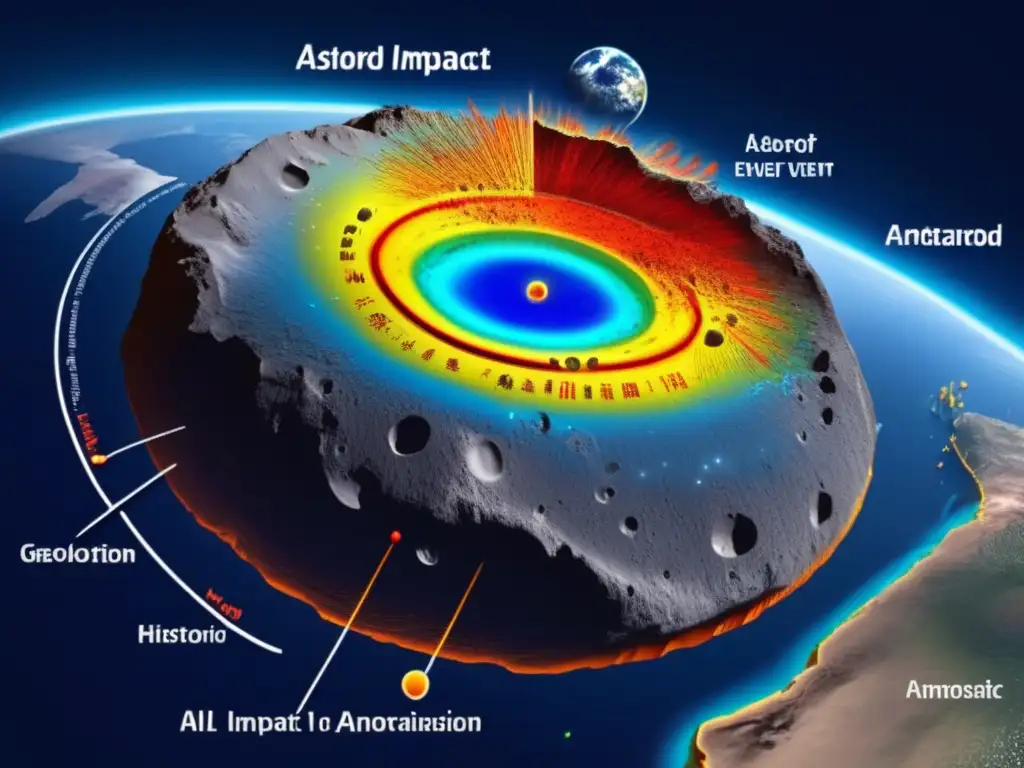From Outer Space: Tracing The Trajectory Of Asteroid Impacts

Introduction
Asteroids are small, rocky bodies that are found in a variety of orbits around the Sun. They can range in size from a few meters to several kilometers and have been the subject of fascination for astronomers and scientists for decades. Of the thousands of asteroids that have been identified, some have been known to pose a threat to Earth due to their potential to impact our planet. In this article, we will explore some of the most significant asteroid impacts in history and the scientific efforts to prevent future collisions.
Impact Events in History

The Chicxulub Impact
One of the most catastrophic asteroid impacts in history occurred approximately 66 million years ago when a large asteroid collided with Earth in what is now Mexico's Yucatan Peninsula. The impact caused widespread destruction, leading to the extinction of the dinosaurs and various other species. The resulting crater, known as the Chicxulub crater, measures more than 110 miles in diameter and 12 miles deep. Scientists estimate that the asteroid was about six miles wide and impacted Earth at a speed of around 40,000 miles per hour.
The Tunguska Event
In 1908, a massive explosion occurred in the skies above the Siberian region of Tunguska. The explosion, which is believed to have been caused by an asteroid or comet, flattened trees over an area of more than 770 square miles. The blast was so powerful that it was felt as far away as Britain. Although no one was killed, the event highlights the potential danger posed by asteroids and other extraterrestrial objects.
The Barringer Crater
The Barringer Crater, also known as the Meteor Crater, is a famous impact crater located in Arizona. The crater was formed approximately 50,000 years ago when a small asteroid or comet collided with Earth. The impact created a hole that measures approximately 3,900 feet in diameter and 570 feet deep. It is one of the best-preserved impact craters on Earth and has become a popular tourist attraction.
Asteroid Impact Prevention

The Role of NASA
NASA's Near-Earth Object (NEO) program is responsible for detecting and monitoring potentially hazardous asteroids and comets. The program uses ground-based telescopes and space-based observatories to track the orbits of these objects and assess the potential risk of impact. In addition, NASA is also developing technologies designed to deflect dangerous asteroids away from Earth if they are detected in time.
Deflection Techniques
Several techniques have been proposed for deflecting asteroids away from Earth, including:
- Gravity tractor: A spacecraft would be placed near the asteroid's orbit and use its gravitational pull to slowly alter the object's trajectory.
- Kinetic impactor: A spacecraft would collide with the asteroid at high speed, altering its course through sheer force.
- Nuclear explosion: A nuclear device would be detonated near the asteroid, creating an explosive force that would push the object off course.
Frequently Asked Questions

-
What are the chances of an asteroid impact?
The chances of a large asteroid impacting Earth in the near future are relatively low, but the possibility still exists. In recent years, several near misses have highlighted the need for continued monitoring and detection efforts.
-
Has a spacecraft ever visited an asteroid?
Yes, several spacecraft have visited asteroids in recent years, including NASA's NEAR Shoemaker and Japan's Hayabusa missions.
-
Why are asteroids often referred to as "primitive" bodies?
Asteroids are often described as "primitive" because they are believed to be remnants from the early Solar System. By studying asteroids, scientists hope to gain insights into the formation and evolution of the planets.
-
Can an asteroid impact be predicted with certainty?
While astronomers can predict the orbits of asteroids with a high degree of accuracy, it is more difficult to predict their potential impact on Earth. The nature of these objects makes them unpredictable, which is why continuous monitoring is so important.
-
How can individuals prepare for a potential asteroid impact?
Individuals can take steps to prepare for a potential asteroid impact by staying informed and having an emergency plan in place. In the event of an impact, it is important to stay calm and follow any evacuation orders issued by authorities.
Conclusion
Asteroid impacts have played a significant role in shaping the history of our planet, and they continue to pose a potential threat to human existence. However, through continued scientific research and technological advancements, we are better equipped than ever to detect and prevent these catastrophic events. By staying informed and supporting ongoing asteroid monitoring efforts, we can help ensure the safety and well-being of future generations.
Thank you for taking the time to read this article. If you have any thoughts or questions, please feel free to share them in the comments section below. And be sure to check out www.asteroidrealm.com for more fascinating insights into the world of asteroids.
Additional Resources

 Crater Creation: The Science Of Asteroid Impact Sites
Crater Creation: The Science Of Asteroid Impact Sites The Asteroid Advantage: Impact-Induced Evolutionary Change
The Asteroid Advantage: Impact-Induced Evolutionary Change Painting A Picture Of The Past: Impact Craters And Their Stories
Painting A Picture Of The Past: Impact Craters And Their StoriesIf you want to discover more articles similar to From Outer Space: Tracing The Trajectory Of Asteroid Impacts, you can visit the Asteroid Impacts category.
Leave a Reply

Articulos relacionados: